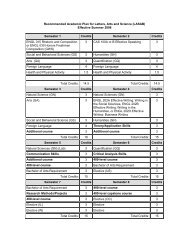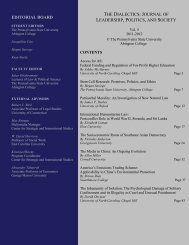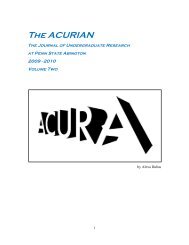Vol. III - Penn State Abington
Vol. III - Penn State Abington
Vol. III - Penn State Abington
You also want an ePaper? Increase the reach of your titles
YUMPU automatically turns print PDFs into web optimized ePapers that Google loves.
one described in the opening paragraph of this paper, we need to take action now in order to curb<br />
the rise of violence and socioeconomic grievance in the cities of the developing world.<br />
There are three main reasons why Americans and other Westerners should be concerned<br />
about the uncontrolled growth of cities in the world’s poorest countries.<br />
1) Conflict-ridden cities in failing states often require Western military intervention.<br />
The conflict analyst David Keen once noted that “those who wish to facilitate peace will be well<br />
advised to understand the nature of war” (Keen, 2000). The nature of modern warfare<br />
increasingly requires Western militaries to fight in the urban centers of the developing world.<br />
They fight both as aggressors (such as the Americans in Fallujah or the Israelis in Gaza) and as<br />
peacekeepers (such as the Canadians in Kigali or the Norwegians in Beirut). As a result, US<br />
military analysts and consultants have intensively explored the realities of fighting in the urban<br />
“battlespaces” of the developing world. In this area of emerging military literature, there is a<br />
definite consensus that the conflicts of the future will take place not in World War II-style<br />
battlefields; rather, most analysts assert that the violent conflicts of the twenty-first century will<br />
be fought in the rapidly growing cities of the developing world and their informal peripheries<br />
(Peters, 1996; Dalzell, 2006). Recent examples, however, reveal that this is a task which is easier<br />
said than done.<br />
In August 1993, a battalion of US Army Rangers arrived in Mogadishu, Somalia to join<br />
the UN-mandated hunt for the infamous warlord Mohammed Farah Aideed, who was believed to<br />
be guilty of several crimes against humanity. In a botched assault on Aideed’s headquarters, two<br />
US Black Hawk helicopters were shot down, another two were damaged. In addition, eighteen<br />
US personnel were killed, and about eighty were injured (Rosenau, 1997). During the operation,<br />
it is estimated that 312 Somalis (both militiamen and civilians) were killed and that an additional<br />
814 were injured (Rosenau, 1997). The raid was largely a failure, as Aideed himself was not<br />
captured and large numbers of civilian casualties turned the population’s sentiment against the<br />
US force, making it difficult for them to conduct other operations in the area. Although the<br />
official population of Mogadishu was around 500,000, some analysts estimate that the actual<br />
population of the city at the time of the raid was about 1,500,000 as a result of an influx of<br />
refugees seeking asylum from the violence in the countryside (Roseneau, 1997). Aideed’s force<br />
actively recruited these dispossessed former-villagers, for whom it was nearly impossible to find<br />
a job in the conventional economy. Today, the ‘Black Hawk Down’ debacle is largely seen as<br />
one of the most embarrassing failures of the US military, and was essentially a massive waste of<br />
resources not only in terms of finances but in human life as well.<br />
Also in 1993, the Canadian-led UNAMIR mission began operating in Kigali, Rwanda, in<br />
an effort to maintain a peace agreement signed by both belligerents in the Rwandan civil war.<br />
Between April and July 1994, disenchanted ethnic Hutus—mostly in Kigali—began slaughtering<br />
the ethnic Tutsi elements of the population, and managed to kill between 800,000 and 1,200,000<br />
people by the time the violence ended (Reyntjens, 1996). The outnumbered UNAMIR force was<br />
largely unable to stop the killing, even against the Interahamwe—an unorganized militia force<br />
which was armed primarily with machetes and other improvised weapons. A little-acknowledged<br />
fact about the Rwandan genocide is that it was mainly carried out in urban areas by groups which<br />
were organized out of the cities. The Rwandan civil war had created dire economic conditions in<br />
urban centers such as Kigali, and the violence which followed can thus partially be seen as the<br />
unleashing of pent-up frustration at years of unrest and economic decline.<br />
THE DIALECTICS ▲ 2009<br />
www.abington.psu.edu/dialectics<br />
4







